Table of contents
- The Vital Role of Small Factory Businesses in India’s Economy
- Top 10 Small Factory Business ideas
- 1. Pickled and Preserved Food Production
- 2. Paper and Cardboard Products Manufacturing
- 3. Spices and Masala Grinding and Packaging
- 4. Handmade Soap and Cosmetic Production
- 5. Agarbatti (Incense Stick) Manufacturing
- 6. Leather Goods Manufacturing
- 7. Disposable Tableware Manufacturing
- 8. Textile and Garment Manufacturing
- 9. Detergent and Cleaning Products Manufacturing
- 10. Candle Manufacturing
- Conclusion
- Frequently Asked Questions (FAQs)
India’s manufacturing sector offers immense potential for entrepreneurs. Small factory businesses are vital for economic growth, creating jobs, and driving innovation. This article explores ten profitable “small factory ideas” tailored for the Indian market, providing insights into starting your own successful venture.
The Vital Role of Small Factory Businesses in India’s Economy
Small factory businesses are the backbone of India’s manufacturing sector, playing a crucial role in driving economic growth, creating employment, and fostering innovation. Their significance can be highlighted through several key aspects:
- Employment Generation:
- Small factories are labor-intensive, creating numerous job opportunities, especially in rural and semi-urban areas. This helps reduce unemployment and promotes inclusive economic growth.
- These businesses often provide employment to individuals with diverse skill sets, contributing to the overall skill development of the workforce.
- Economic Decentralization:
- Small factories facilitate the decentralization of economic activity, preventing the concentration of industries in a few urban centers.
- This helps in regional development, reducing disparities between urban and rural areas.
- Fostering Entrepreneurship:
- Small factory businesses are ideal platforms for aspiring entrepreneurs to realize their business ideas with relatively lower capital investments.
- They encourage innovation and creativity, leading to the development of unique products and services.
- Supporting Local Economies:
- Small factories often source raw materials and services from local suppliers, boosting the local economy and creating a ripple effect of economic benefits.
- They contribute to the growth of ancillary industries and support local businesses.
- Promoting “Make in India” Initiative:
- Small factories play a critical role in realizing the “Make in India” initiative by promoting domestic manufacturing and reducing reliance on imports.
- They contribute to the development of a strong and self-reliant manufacturing sector.
- Flexibility and Adaptability:
- Small factories are known to be very flexible, and able to adapt to changing market demands far faster than larger factories.
- This allows them to fill niche markets, and provide specialized products.
- Contribution to Exports:
- Many small factories produce products that have a strong export value. These businesses provide unique products to the world market, and increase Indias foreign exchange.
Top 10 Small Factory Business ideas
1. Pickled and Preserved Food Production
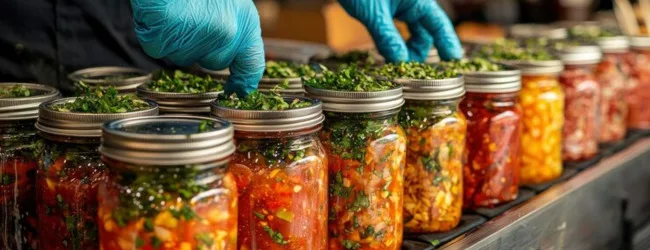
Establishing a small-scale manufacturing unit to produce a variety of pickles, jams, preserves, and chutneys, leveraging traditional Indian recipes and locally sourced ingredients.
a. Why this Idea:
- Cultural Significance: Pickles and preserves are integral to Indian cuisine, with diverse regional variations, ensuring consistent demand.
- Long Shelf Life: These products have extended shelf lives, minimizing spoilage and inventory management challenges.
- Growing Demand for Convenience: Modern lifestyles drive the need for ready-to-eat traditional foods.
- Artisanal and Homemade Trend: Consumers increasingly seek authentic, handcrafted food products.
- Export Potential: Unique Indian pickles and preserves have growing international appeal.
b. Licenses Required:
- FSSAI (Food Safety and Standards Authority of India) License: Essential for food manufacturing and sales, ensuring compliance with safety and hygiene standards.
- Trade License: Obtained from the local municipal authority to operate a business.
- GST (Goods and Services Tax) Registration: Necessary for tax compliance and interstate sales.
c. Investment Required: ₹2-5 lakhs (approximate):
- Stainless steel cooking and processing equipment (₹50,000 – ₹1,00,000).
- Sterilization and packaging machines (₹50,000 – ₹1,50,000).
- Raw material procurement (fruits, vegetables, spices, oils) (₹50,000 – ₹1,00,000).
- Packaging materials (jars, bottles, labels) (₹20,000 – ₹50,000).
- Initial marketing and distribution costs (₹30,000 – ₹50,000).
d. How to Sell:
- Local Markets and Bazaars: Direct sales to consumers at local markets and weekly bazaars.
- Retail Grocery Stores and Supermarkets: Partnering with local retailers to stock products.
- Online Food Delivery Platforms and E-commerce Websites: Reaching a wider audience through online sales.
- Direct Sales to Restaurants and Catering Services: Supplying bulk orders to food service businesses.
- Farmers’ Markets and Organic Food Stores: Targeting health-conscious consumers.
e. Any other Requirements:
- Hygiene and Sanitation: Strict adherence to food safety and hygiene standards is crucial.
- Quality Control: Implementing consistent quality control measures to maintain product quality.
- Storage Facilities: Proper storage facilities to ensure product freshness and shelf life.
- Packaging: Attractive and informative packaging to enhance product appeal.
f. Challenges in the Idea:
- Seasonal Availability of Raw Materials: Fluctuations in the availability and prices of seasonal produce.
- Maintaining Consistent Quality: Ensuring consistent taste and quality across batches.
- Competition: Competition from established brands and local producers.
- Shelf-Life Management: Managing the shelf life of perishable products.
g. How to overcome the Challenges:
- Contract Farming: Establishing contracts with local farmers for a consistent supply of raw materials.
- Standardized Recipes: Developing and adhering to standardized recipes and processing procedures.
- Unique Flavor Profiles: Focusing on unique flavor profiles and high-quality ingredients to differentiate products.
- Efficient Inventory Management: Implementing effective inventory management systems.
h. Example: Imagine a small factory in a village in Rajasthan that makes unique mango pickles with local spices. They sell these pickles in clean, reusable glass jars at nearby markets and to local grocery stores.
ALSO READ | 10 Highly Profitable Manufacturing Business Ideas Under ₹50,000
2. Paper and Cardboard Products Manufacturing
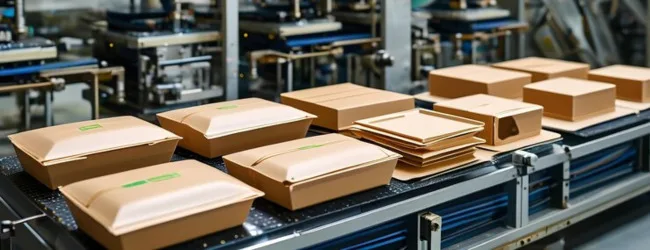
Setting up a manufacturing unit for producing eco-friendly paper bags, cardboard boxes, and other packaging materials.
a. Why this Idea:
- Environmental Awareness: Growing demand for sustainable alternatives to plastic packaging.
- E-commerce Growth: The expanding e-commerce sector drives the need for packaging solutions.
- Government Regulations: Increasing regulations against single-use plastics.
- Customization Options: Ability to offer customized packaging solutions.
b. Licenses Required:
- Trade License: To legally operate the business.
- GST Registration: For tax compliance.
c. Investment Required: ₹3-7 lakhs (approximate):
- Paper cutting and folding machines (₹1,00,000 – ₹2,50,000).
- Cardboard corrugating and cutting machines (₹1,50,000 – ₹3,00,000).
- Printing and labeling equipment (₹50,000 – ₹1,00,000).
- Raw material procurement (paper rolls, cardboard sheets) (₹50,000 – ₹1,00,000).
d. How to Sell:
- Local Businesses: Retail stores, restaurants, bakeries, etc.
- E-commerce Platforms: Online marketplaces and direct sales.
- Packaging Suppliers and Distributors: Partnering with established distributors.
- Direct Sales to Manufacturers and Exporters: Supplying packaging to other industries.
e. Any other Requirements:
- Quality Control: Ensuring durable and reliable products.
- Customization: Offering tailored packaging solutions.
- Efficient Production: Timely delivery and efficient operations.
f. Challenges in the Idea:
- Competition: From larger manufacturers with economies of scale.
- Raw Material Prices: Fluctuations in paper and cardboard prices.
- Quality Consistency: Maintaining consistent product quality.
g. How to overcome the Challenges:
- Niche Markets: Focusing on customized solutions and specific industries.
- Supplier Relationships: Building strong relationships with raw material suppliers.
- Efficient Processes: Investing in efficient production and quality control.
h. Example: Think of a factory in a small industrial area that makes sturdy cardboard boxes for local businesses that sell sweets and snacks. They also produce simple paper bags for small shops.
3. Spices and Masala Grinding and Packaging
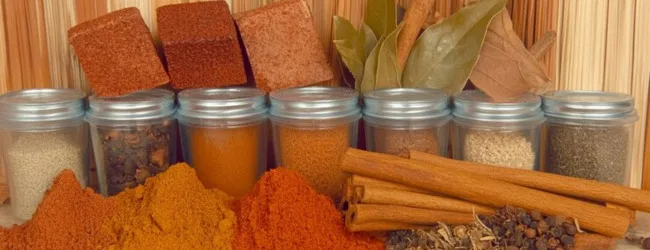
Setting up a small factory to grind and blend various spices and masala mixes, catering to regional and specific culinary needs.
a. Why this Idea:
- High Demand: India is a major consumer and producer of spices, with consistent demand.
- Authenticity: Growing preference for authentic and high-quality spice blends.
- Home Cooking Trend: Increased interest in home cooking and traditional recipes.
- Regional Specialties: Opportunity to cater to specific regional tastes and preferences.
b. Licenses Required:
- FSSAI License: Essential for food processing and packaging.
- Trade License: To operate the business legally.
- GST Registration: For tax compliance.
c. Investment Required: ₹2-4 lakhs (approximate):
- Spice grinding machines (₹50,000 – ₹1,00,000).
- Blending and mixing equipment (₹30,000 – ₹70,000).
- Packaging machines (₹40,000 – ₹80,000).
- Raw material procurement (whole spices) (₹80,000 – ₹1,50,000).
d. How to Sell:
- Local Grocery Stores and Supermarkets: Partnering with retailers.
- Online Food Marketplaces and E-commerce Websites: Reaching a wider audience.
- Direct Sales to Restaurants and Catering Services: Supplying bulk orders.
- Farmers’ Markets and Organic Food Stores: Targeting specific consumer segments.
e. Any other Requirements:
- Quality Control: Ensuring purity and freshness of spices.
- Proper Packaging: Maintaining aroma and flavor.
- Hygiene and Sanitation: Strict adherence to food safety standards.
f. Challenges in the Idea:
- Maintaining Consistent Quality: Ensuring consistent flavor profiles.
- Competition: From established brands and local producers.
- Sourcing Raw Materials: Obtaining high-quality spices.
g. How to overcome the Challenges:
- Reputable Suppliers: Sourcing spices from trusted suppliers and farmers.
- Standardized Recipes: Developing and adhering to consistent blending procedures.
- Quality Testing: Investing in quality control and testing.
- Unique Blends: Focusing on unique spice blends and regional specialties.
h. Example: A small factory grinds and mixes common spices like turmeric, chili powder, and garam masala. They package these spices in small, sealed pouches and sell them to local grocery stores and markets.
💡 Pro Tip: If you want to start a Manufacturing Business but have too many doubts, connect with a Manufacturing Business expert from Boss Wallah for guidance – https://bw1.in/1116
4. Handmade Soap and Cosmetic Production
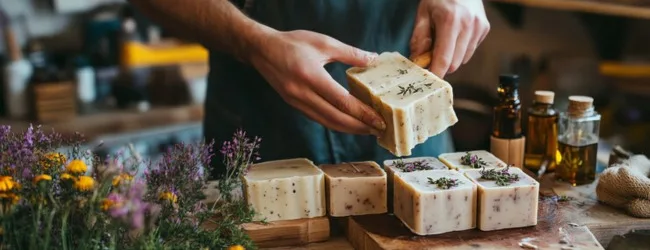
Manufacturing natural and organic soaps, lotions, and other cosmetic products using traditional and modern formulations.
a. Why this Idea:
- Natural Products Demand: Growing demand for chemical-free personal care products.
- Organic Ingredients: Increasing awareness of the benefits of organic ingredients.
- Artisanal Products: Rising interest in handcrafted products.
- Niche Market: opportunity to serve a specific niche.
b. Licenses Required:
- Trade License: To operate the business legally.
- GST Registration: For tax compliance.
- Cosmetic Manufacturing License: As required by the relevant authorities.
c. Investment Required: ₹3-6 lakhs (approximate):
- Mixing and blending equipment (₹70,000 – ₹1,50,000).
- Molding and cutting tools (₹30,000 – ₹60,000).
- Packaging machines (₹50,000 – ₹1,00,000).
- Raw material procurement (essential oils, natural extracts) (₹1,00,000 – ₹2,00,000).
d. How to Sell:
- Online Platforms and E-commerce Websites: Reaching a wide customer base.
- Local Stores and Boutiques: Partnering with retailers.
- Organic Markets and Health Food Stores: Targeting specific consumer segments.
- Direct Sales: Through social media and personal networks.
e. Any other Requirements:
- Formulation Knowledge: Thorough understanding of cosmetic formulations and safety standards.
- Quality Control: Ensuring product consistency and safety.
- Packaging: Attractive and informative packaging.
f. Challenges in the Idea:
- Formulation Consistency: Maintaining consistent quality and shelf life.
- Regulatory Compliance: Meeting product safety and labeling requirements.
- Competition: From established brands.
g. How to overcome the Challenges:
- Research and Testing: Investing in thorough research and testing.
- Expert Partnership: Partnering with experts in cosmetic formulation.
- Unique Ingredients: Focusing on unique and high-quality ingredients.
- Brand Identity: Building a strong brand and reputation.
h. Example: A small workshop makes natural soaps using ingredients like coconut oil and herbs. They wrap these soaps in simple paper and sell them at local craft fairs and small shops.
5. Agarbatti (Incense Stick) Manufacturing

Producing a variety of incense sticks with different fragrances and formulations, catering to religious and household needs.
a. Why this Idea:
- Consistent Demand: Incense sticks are used in religious ceremonies and households.
- Aromatherapy Trend: Growing interest in natural fragrances.
- Low Investment: Relatively low startup costs.
- Simple Manufacturing: Basic production process.
b. Licenses Required:
- Trade License: To operate the business legally.
- GST Registration: For tax compliance.
c. Investment Required: ₹1-3 lakhs (approximate):
- Agarbatti making machines (₹30,000 – ₹70,000).
- Fragrance blending equipment (₹20,000 – ₹50,000).
- Packaging machines (₹20,000 – ₹50,000).
- Raw material procurement (bamboo sticks, charcoal powder, fragrances) (₹30,000 – ₹1,30,000).
d. How to Sell:
- Local Shops and Religious Stores: Partnering with retailers.
- Online Platforms and E-commerce Websites: Reaching a wider audience.
- Direct Sales: To temples and religious organizations.
e. Any other Requirements:
- Quality Raw Materials: Sourcing good raw materials and fragrance blends.
- Proper Drying: Ensuring proper drying to maintain fragrance.
- Safe Handling: Safe handling of chemicals and fragrances.
f. Challenges in the Idea:
- Competition: From established brands and small-scale producers.
- Fragrance Consistency: Maintaining consistent fragrance quality.
- Raw Material Sourcing: Obtaining quality raw materials.
g. How to overcome the Challenges:
- Unique Blends: Focusing on unique fragrance blends.
- Efficient Production: Investing in efficient production processes.
- Strong Distribution: Building a strong distribution network.
h. Example: A small unit produces basic incense sticks with sandalwood and rose fragrances. They pack them in simple paper packets and sell them to local temples and small shops.
6. Leather Goods Manufacturing
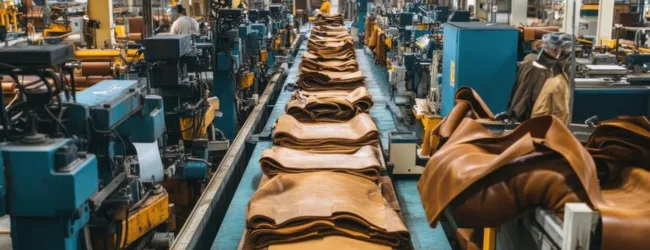
Setting up a small factory to produce a range of leather goods, including wallets, belts, bags, and accessories, targeting both local and potentially export markets with a focus on quality and craftsmanship.
a. Why this Idea:
- High Demand for Quality: There’s a consistent demand for durable, well-made leather goods.
- Artisanal and Premium Appeal: Handcrafted leather items are often perceived as high-value and unique.
- Export Potential: India has a long tradition of leatherwork, providing opportunities for export.
- Customization Options: Offering personalized or custom-designed items can attract niche markets.
b. Licenses Required:
- Trade License: To legally operate the manufacturing business.
- GST Registration: For tax compliance and interstate sales.
c. Investment Required: ₹4-8 lakhs (approximate):
- Leather cutting and sewing machines (₹1,50,000 – ₹3,00,000): Industrial sewing machines, skiving machines, and cutting tools.
- Finishing and polishing equipment (₹50,000 – ₹1,00,000): Buffing machines, edge finishing tools.
- Raw material procurement (leather hides, tools, accessories) (₹1,00,000 – ₹2,50,000): Various types of leather, buckles, zippers, thread.
- Tools and other supplies(₹100,000-150,000) : hammers, hole punchers, rivets, and other tools.
d. How to Sell:
- Local Markets and Shops: Direct sales to consumers at local bazaars, craft fairs, and small boutiques.
- Online Platforms: Selling through e-commerce websites, online marketplaces (like Amazon, Flipkart), and social media platforms.
- Export: Partnering with export companies or directly selling to international buyers.
- Corporate Gifts: Supplying customized leather goods to businesses for corporate gifting.
e. Any other Requirements:
- Skilled Labor: Hiring or training skilled artisans with expertise in leather crafting.
- Quality Control: Implementing strict quality checks to ensure durable and well-finished products.
- Sourcing Quality Leather: Establishing relationships with reliable leather suppliers.
- Design capabilities: understanding design and current trends.
f. Challenges in the Idea:
- Sourcing Quality Leather: Obtaining high-quality leather hides at competitive prices.
- Skilled Labor Availability: Finding and retaining skilled leatherworkers.
- Competition from Established Brands: Competing with established leather goods manufacturers.
- Fluctuations in Raw Material Prices: Dealing with price volatility in leather markets.
g. How to overcome the Challenges:
- Establish Strong Supplier Relationships: Building long-term relationships with leather suppliers.
- Invest in Training and Development: Providing training to workers to enhance their skills.
- Focus on Niche Markets and Unique Designs: Differentiating products by offering unique designs and catering to specific customer segments.
- Explore Sustainable Sourcing: Considering ethically sourced or vegetable-tanned leather.
h. Example: A small workshop makes simple leather belts and wallets. They sell these items at local markets and to small shops that sell leather goods.
7. Disposable Tableware Manufacturing

Setting up a factory to produce eco-friendly disposable plates, cups, and cutlery using biodegradable materials like sugarcane bagasse or bamboo, catering to the increasing demand for sustainable alternatives.
a. Why this Idea:
- Growing Environmental Awareness: Increasing consumer awareness of the negative impact of plastic waste.
- Rising Demand for Sustainable Alternatives: Growing preference for eco-friendly disposable tableware.
- Government Regulations: Stricter regulations against single-use plastics.
- Event and Catering Industry: High demand from event organizers, catering services, and food vendors.
b. Licenses Required:
- Trade License: To legally operate the manufacturing business.
- GST Registration: For tax compliance.
c. Investment Required: ₹3-6 lakhs (approximate):
- Molding and forming machines (₹1,00,000 – ₹2,00,000): Machines for shaping and molding biodegradable materials.
- Cutting and packaging equipment (₹80,000 – ₹1,50,000): Machines for cutting, shaping, and packaging the products.
- Raw material procurement (sugarcane bagasse, bamboo pulp) (₹1,20,000 – ₹2,50,000): Obtaining raw materials from suppliers.
d. How to Sell:
- Event Organizers and Caterers: Direct sales to event management companies and catering services.
- Restaurants and Food Stalls: Supplying to local restaurants, food vendors, and street food stalls.
- Retail Stores: Selling to supermarkets, grocery stores, and retail outlets.
- Online Platforms: Selling through e-commerce websites and online marketplaces.
e. Any other Requirements:
- Raw Material Sourcing: Establishing reliable sources for biodegradable raw materials.
- Production Efficiency: Optimizing production processes to ensure cost-effectiveness.
- Quality Control: Implementing quality checks to maintain product durability and hygiene.
- Storage: Proper storage of raw materials and finished goods.
f. Challenges in the Idea:
- Raw Material Costs: Sourcing biodegradable materials at competitive prices.
- Maintaining Consistent Quality: Ensuring consistent product quality and durability.
- Competition from Existing Manufacturers: Competing with established manufacturers of disposable tableware.
g. How to overcome the Challenges:
- Establish Long-Term Supplier Contracts: Securing stable raw material supplies through long-term contracts.
- Invest in Efficient Production Technology: Implementing efficient production processes to reduce costs.
- Focus on Product Innovation and Unique Designs: Differentiating products through innovative designs and features.
h. Example: A small factory produces disposable plates and bowls made from sugarcane waste. They sell these eco-friendly products to local food vendors and event caterers.
ALSO READ | Start an Online Marketing Home based Business : Step-by-Step Guide for 2025
8. Textile and Garment Manufacturing
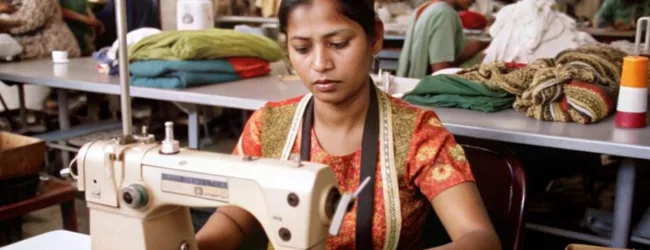
Setting up a small factory to produce specific types of garments or textiles, such as uniforms, specialized fabrics, or home textiles, catering to niche markets with a focus on quality and customization.
a. Why this Idea:
- Consistent Demand for Specific Garments: Certain types of garments, like uniforms or workwear, have consistent demand.
- Customization Opportunities: Offering tailored solutions to meet specific client requirements.
- Availability of Skilled Labor: India has a large pool of skilled textile workers.
- Niche Market Focus: Targeting specific industries or customer segments.
b. Licenses Required:
- Trade License: To legally operate the manufacturing business.
- GST Registration: For tax compliance.
c. Investment Required: ₹5-10 lakhs (approximate):
- Sewing machines and textile machinery (₹2,00,000 – ₹4,00,000): Industrial sewing machines, cutting machines, and specialized textile equipment.
- Cutting and finishing equipment (₹1,00,000 – ₹2,00,000): Machines for cutting patterns, overlocking, and finishing garments.
- Raw material procurement (fabric, threads, buttons) (₹2,00,000 – ₹4,00,000): Sourcing quality fabrics, threads, and accessories.
d. How to Sell:
- Direct Sales to Businesses and Organizations: Supplying uniforms or textiles to schools, hospitals, hotels, and other organizations.
- Online Platforms: Selling through e-commerce websites and online marketplaces.
- Retail Stores: Partnering with retail stores or boutiques to sell specialized garments.
- Export: Exporting specialized textiles or garments to international buyers.
e. Any other Requirements:
- Skilled Labor: Hiring or training skilled tailors, seamstresses, and textile workers.
- Quality Control: Implementing rigorous quality checks to ensure durable and well-made garments.
f. Challenges in the Idea:
- Labor Costs and Availability: Managing labor costs and ensuring a steady supply of skilled workers.
- Maintaining Consistent Product Quality: Ensuring consistent quality across all garments.
- Competition from Large Manufacturers: Competing with established garment manufacturers with economies of scale.
- Keeping Up with Fashion Trends: Adapting to changing fashion trends and customer preferences.
g. How to overcome the Challenges:
- Invest in Automation and Efficient Technology: Implementing automated processes and efficient machinery to reduce labor costs and improve productivity.
- Provide Training and Development: Offering training programs to enhance workers’ skills and ensure quality.
- Focus on Specialized Niches and Unique Designs: Differentiating products by catering to specific industries or offering unique garment designs.
- Build Strong Relationships with Suppliers: Establishing reliable sources for quality fabrics and accessories.
h. Example: A small sewing unit makes simple school uniforms. They sell these uniforms directly to local schools and uniform shops.
9. Detergent and Cleaning Products Manufacturing
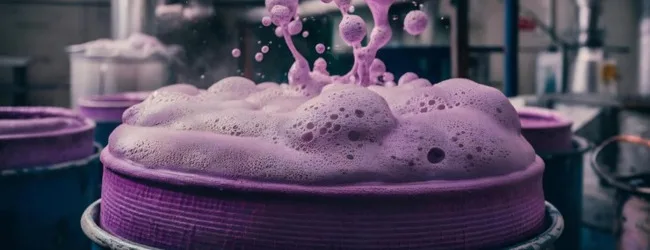
Setting up a small factory to produce eco-friendly detergents, cleaners, and disinfectants, catering to the growing demand for safe and sustainable cleaning solutions.
a. Why this Idea:
- Growing Environmental Awareness: Increasing consumer awareness of the harmful effects of chemical cleaners.
- Rising Demand for Natural Products: Growing preference for safe and natural cleaning solutions.
- Niche Market Potential: Targeting specific segments, such as households with allergies or eco-conscious consumers.
- Home based business potential: Many of the products can be made with simple equipment.
b. Licenses Required:
- Trade License: To legally operate the manufacturing business.
- GST Registration: For tax compliance.
- Product Safety Certifications: Obtaining necessary certifications for product safety and labeling.
c. Investment Required: ₹3-6 lakhs (approximate):
- Mixing and blending equipment (₹70,000 – ₹1,50,000): Machines for mixing and blending raw materials.
- Packaging machines (₹50,000 – ₹1,00,000): Machines for filling and sealing containers.
- Raw material procurement (natural ingredients, essential oils) (₹1,00,000 – ₹2,00,000): Sourcing natural ingredients and essential oils.
d. How to Sell:
- Local Stores and Supermarkets: Partnering with retail stores and supermarkets.
- Online Platforms: Selling through e-commerce websites and online marketplaces.
- Direct Sales to Businesses and Organizations: Supplying cleaning products to offices, hotels, and other businesses.
e. Any other Requirements:
- Quality Formulation and Testing: Ensuring product effectiveness and safety through rigorous testing.
- Proper Packaging and Labeling: Complying with labeling regulations and using eco-friendly packaging.
- Safety Protocols: Implementing safety measures for handling chemicals and ingredients.
f. Challenges in the Idea:
- Formulation Consistency and Shelf Life: Maintaining consistent quality and ensuring product stability.
- Regulatory Compliance: Adhering to product safety and labeling regulations.
- Competition from Established Brands: Competing with established cleaning product manufacturers.
g. How to overcome the Challenges:
- Invest in Research and Testing: Conducting thorough research and testing to ensure product effectiveness and safety.
- Partner with Experts: Collaborating with chemists or formulation experts.
- Focus on Unique Formulations and Natural Ingredients: Differentiating products through unique formulations and natural ingredients.
- Obtain Necessary Certifications: Getting all the required certifications.
h. Example: A small factory produces a simple liquid dish washing soap, and packs it into plastic bottles to sell to local stores.
10. Candle Manufacturing
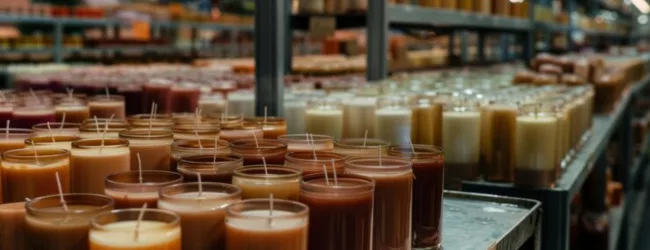
Setting up a small factory to produce scented, decorative, and functional candles, catering to the growing demand for home decor and aromatherapy products.
a. Why this Idea:
- High Demand for Home Decor: Candles are popular for home decor and ambiance.
- Aromatherapy Trend: Growing interest in scented candles for relaxation and wellness.
- Gift Market: Candles are popular gifts for various occasions.
- Low Start up cost: Can be started with simple equipment.
b. Licenses Required:
- Trade License: To legally operate the business.
- GST Registration: For tax compliance.
c. Investment Required: ₹1-3 lakhs (approximate):
- Melting pots and pouring equipment (₹20,000 – ₹50,000).
- Molds and containers (₹30,000 – ₹70,000).
- Raw materials (wax, wicks, fragrances) (₹50,000 – ₹1,80,000).
d. How to Sell:
- Online Platforms: Selling through e-commerce websites and online marketplaces.
- Local Craft Stores and Gift Shops: Partnering with local retailers.
- Direct Sales at Craft Fairs and Markets: Selling directly to consumers at craft events.
e. Any other Requirements:
- Quality Wax and Fragrance Blending: Using high-quality wax and creating unique fragrance blends.
- Attractive Packaging: Designing appealing packaging to enhance product value.
- Safety Handling: Ensuring safe handling of wax and fragrances.
f. Challenges in the Idea:
- Competition: Competing with established candle brands and small-scale producers.
- Fragrance Consistency: Maintaining consistent fragrance quality across batches.
- Safe Handling of Wax: Ensuring safe handling of hot wax and flammable materials.
g. How to overcome the Challenges:
- Unique Fragrance Blends: Developing unique and appealing fragrance combinations.
- Focus on Unique Designs: Creating visually appealing candle designs.
- Safety Training: Providing safety training to workers.
h. Example: A small workshop makes basic scented candles using wax and essential oils. They sell these candles at local gift shops and craft fairs.
Need Expert Guidance?
Starting a business can be challenging, but you don’t have to do it alone! At Boss Wallah, our 2,000+ business experts are ready to provide valuable insights and guidance. Whether you need help with marketing, finance, sourcing, or any other area of any business, our business experts are here to help you succeed- https://bw1.in/1116
Confused about Which Business to Start?
Want to start your own business but unsure which one to choose? Explore Boss Wallah, where you’ll find 500+ courses by successful business owners, featuring practical, step-by-step guides on starting and growing various businesses. Find your perfect business idea today – https://bw1.in/1111
Conclusion
India’s vibrant entrepreneurial spirit, coupled with its rich resources and growing market, creates a fertile ground for small factory businesses to flourish. By leveraging innovative ideas, focusing on quality, and adapting to the evolving market landscape, aspiring entrepreneurs can establish thriving manufacturing ventures. These small factories not only contribute significantly to the economy but also empower local communities, create employment, and promote the “Make in India” initiative. With strategic planning, dedication, and a customer-centric approach, these businesses can pave the way for a prosperous and self-reliant manufacturing future in India.
Frequently Asked Questions (FAQs)
1 . What is the ideal initial investment for starting a small factory business in India?
- The ideal initial investment varies significantly depending on the type of manufacturing. Generally, it can range from ₹1 lakh for simpler operations like candle making to ₹10 lakhs for more complex setups like textile manufacturing.
2 . What are the essential licenses and permits required to start a small factory?
- Essential licenses include a Trade License from the local municipality, GST Registration, and industry-specific licenses such as FSSAI for food products or cosmetic manufacturing licenses.
3 . How can I secure funding for my small factory business?
- Funding options include personal savings, bank loans, government schemes like the Pradhan Mantri Mudra Yojana (PMMY), and venture capital for promising startups.
4 . What are effective strategies for marketing products manufactured in a small factory?
- Effective strategies include online platforms (e-commerce, social media), local markets, retail partnerships, direct sales to businesses, and participation in trade fairs.
5 . How can I ensure quality control in my small factory’s production process?
- Implement standardized operating procedures, invest in quality testing equipment, train employees on quality standards, and establish a feedback mechanism.
6 . What are the common challenges faced by small factory owners in India?
- Common challenges include sourcing quality raw materials, managing labor costs, maintaining consistent product quality, complying with regulations, and competing with larger manufacturers.
7 . How can I source reliable suppliers for raw materials?
- Build relationships with local suppliers, attend industry trade shows, use online supplier directories, and consider forming partnerships with farmers or producers for direct sourcing.
8 . What government schemes are available to support small factory businesses in India?
- Schemes like the Pradhan Mantri Mudra Yojana (PMMY), Credit Guarantee Fund Trust for Micro and Small Enterprises (CGTMSE), and various state-level initiatives provide financial assistance and support to small businesses.
9 . How important is packaging for products from a small factory?
- Packaging is very important. It protects the product, and also is a valuable tool for marketing. Good packaging can set a product apart from the competition.
10 . What are key considerations for choosing a location for a small factory?
- Key considerations include proximity to raw materials, access to transportation, availability of skilled labor, cost of land or rent, and compliance with zoning regulations.


